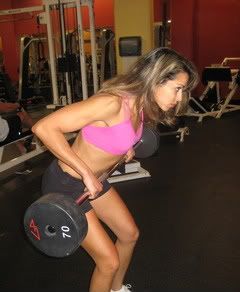Top Ten Stealth Strategies for Maximizing Your Strength Training Results
1) Never sacrifice quality for quantity. This is the first commandment for athletic success. Violate it and prepare to fail.
2) Target the weakest link. If you’re naturally strong, train for speed and/or endurance. If you’re naturally fast, train for strength.
3) For athletes, strength training is a supplementary, not a primary, activity. If time and energy are at a premium, focus your efforts on your sport practice sessions before supplementary training activities.
4) Minimize redundancy: Redundant systems are a great safety feature in aircraft design, but not such a good idea when it comes to program design. Since there are specific limits to one’s time and energy (and since injury and overtraining are a constant threat to athletes and fitness enthusiasts alike), it makes sense to use that time and energy wisely. – ” the two movements are almost identical save for the slight variation in hand position. Instead, a better choice might be single-arm 45-degree dumbbell incline curls and straight bar preacher curls. Now we have effectively reduced redundancy to a bare minimum.NOT when you are completely unable to function!
Thus, a fundamental premise of intelligent program design is that of minimizing redundancy. As an example, during a workout, if you decide upon 2-3 exercises for a single muscle, make the exercises as dissimilar as possible. In other words, if you perform two biceps exercises in the same workout, don’t use standing barbell curls and standing EZ-bar curls
5) When switching to a more quality-based style of strength training, work your way to higher intensities gradually. If you typically perform 10-12 reps a set, don’t immediately switch to maximum singles. Instead, spend some time in the 4-6 rep range for several weeks, and then continue toward higher levels of stress as your body becomes accustomed to harder training.
6) Terminate the training component when the quality of the performance erodes by 10% of more,
7) Select strength training exercises on the basis of how well they train large numbers of muscles simultaneously, and also by how well they correspond to fundamental movement patterns. Some examples would be squats, deadlifts, and bench presses (and their variations), various types of pull-ups, lunges, and abdominal exercises.
8) Try to reduce your dependency on soreness. If feeling bad is your goal, sign up for a job as Lennox Lewis’ sparring partner. If progress is your objective, make sure you perform gradually increasing workloads from workout to workout.
9) Avoid RES (Repetitive Error Syndrome): Don’t continue to do workouts or programs that don’t work. Do something else…ANYTHING else.
10) Do all of the above and pick up your medals






Excellent article and great to see yet another guru land here, I will be checking back daily, I think this blog is fantastic Will.
Coach Staley is the man. I’ve used his EDT system and it works.
Thanks for the great advice! I still find it hard to stay focused on training. What do you sugest !
I am a resident of Mumbai, India, I want to tell Will that a visit to this blog and the information that i find here is highly motivating and exciting. I wish more such articles are posted here. I have now begun to recommend the blog to all my friends in India
Thanks for your nice words guys!
OK, for Carlos, I’m not entirely sure how to help you stay focused- perhaps you can be more specific?
At #8 you say “Try to reduce your dependency on soreness.” What exactly do you mean by that? Why I ask is that, after workouts I usually have muscle/joint soreness, especially on the 2nd day after the workout. I always question, is it better that I wait for the soreness to subside before training again?
Hey Sonja, thanks for the question.
Yes, ideally you should wait for soreness to subside before you train the same muscle(s) again, although occasionally training while sore isn’t the end of the World.
However, the main point I’m making is that you shouldn’t seek soreness, nor should you use it as a barometer of how successful or beneficial your workout was. WHAT YOU ACCOMPLISH during thw workout is the true barometer, not what it felt like.
Some real words of wisdom here: “a fundamental premise of intelligent program design is that of minimizing redundancy.” So many fail to use that simple and absolutely true statement it’s scary. They develop all manner of “programs” yet they fail to plan for the redundancy that’s always going to creep up unless a plan to avoid it is already in place. Great advice here. Carry on Charles!
After reading this article, I just feel that I really need more information on the topic. Can you share some more resources please?
After reading the article I don't understand what u mean by "minimizing redundancy" can u please give some examples, because ones redundancy may not be someone else's??